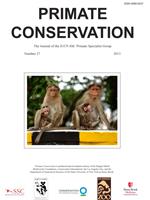The golden langur (Trachypithecus geei), which only became known to science in 1953, is endemic to western Assam, India, and southern Bhutan. The Indian population had been greatly depleted due to a fragmented range and the species was declining radically in 1997 with a pessimistic view for its future. The Golden Langur Conservation Project was begun in 1998 with the goal of protecting the golden langur within its entire Indian range. At the time of the project's initiation, the species was considered India's most endangered primate due to limited range and major deforestation (50%) as a result of a complex political situation from militants in the forest threatening the Assam Forest Department staff, and ethnic violence. The project worked with regional non-governmental organizations and government agencies using the following tools to effect conservation contagion: 1) community meetings; 2) involving villages in forest committees and “Self Help Groups” for economic development; 3) formal seminars; and 4) celebratory events for the creation of the Manas Biosphere Reserve. The project developed conservation contagion, resulting in villages creating their own conservation groups to participate in the project, eventually resulting in 18 community groups forming Forest Protection Forces collectively, under the Unified Forest Conservation Network, to protect almost the entirety of the Manas Biosphere Reserve as well as other reserve forests in Assam. This community protection resulted in an increase of the Indian population of golden langurs from c.1,500 in 1997 to c.5,600 langurs in 2007 to 2012. The project also resulted in the lifting of the “in danger” listing for the Manas Biosphere Reserve by UNESCO. The Indian population of golden langurs mainly resides in the Manas Biosphere along the Bhutan border and in a number of southern isolated reserve forests north of the Brahmaputra River. In adjacent Bhutan, the southern subspecies is contiguous with its Indian counterpart and with the northern subspecies, which has more gray on its arms and tail and inhabits higher altitudes. The Bhutan population is grossly estimated at over 6,600 langurs based on a population census of 60 km2, giving a total estimate for the species in Assam and Bhutan of over 12,000 individuals. The potential for community conservation in Bhutan is also discussed.
How to translate text using browser tools
1 December 2013
Conservation and the Current Status of the Golden Langur in Assam, India, with Reference to Bhutan
R. H. Horwich,
R. Das,
A. Bose

Primate Conservation
Vol. 2013 • No. 27
December 2013
Vol. 2013 • No. 27
December 2013
Assam
Bhutan
golden langur
golden leaf monkey
Presbytis geei
Trachypithecus geei




